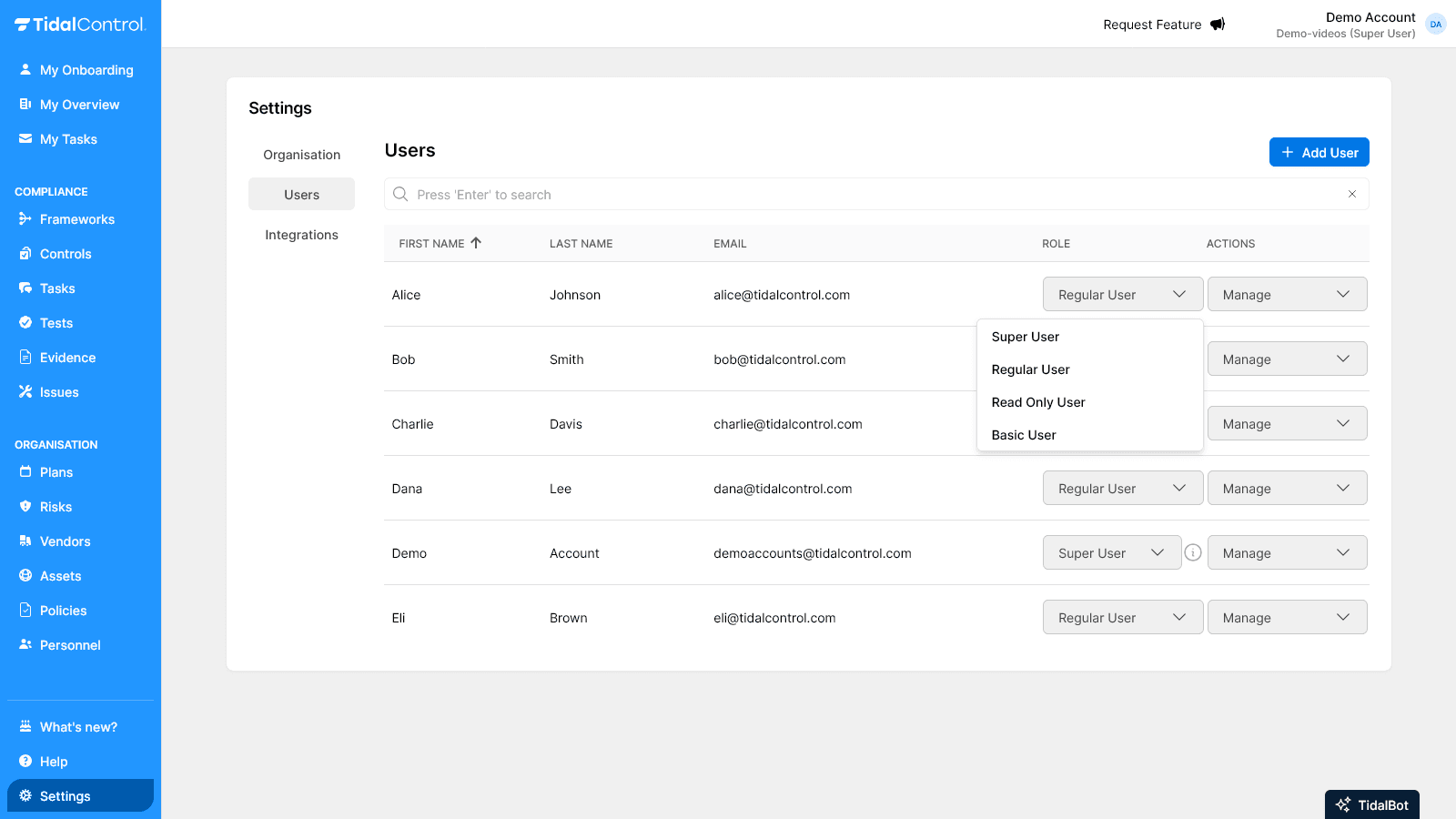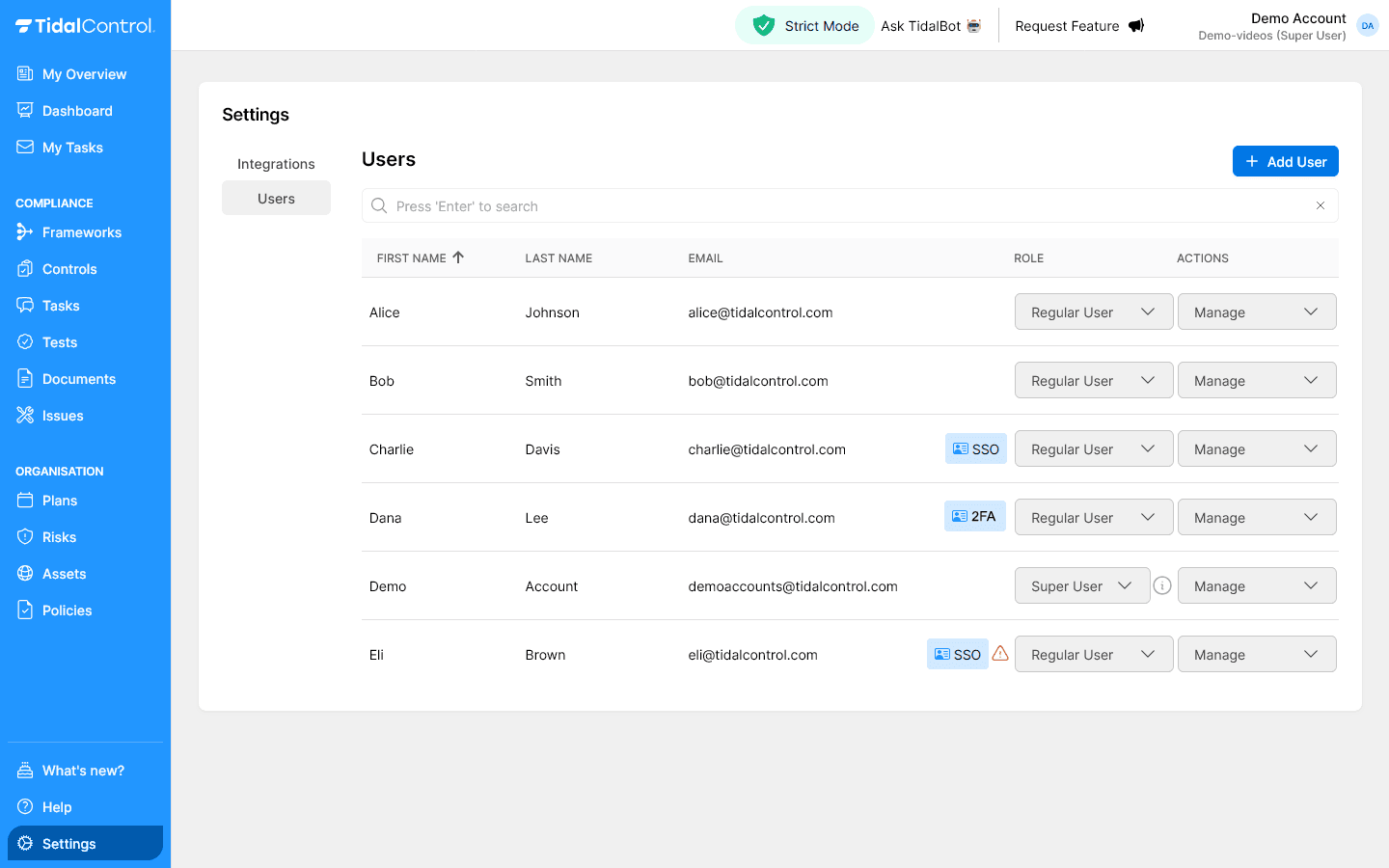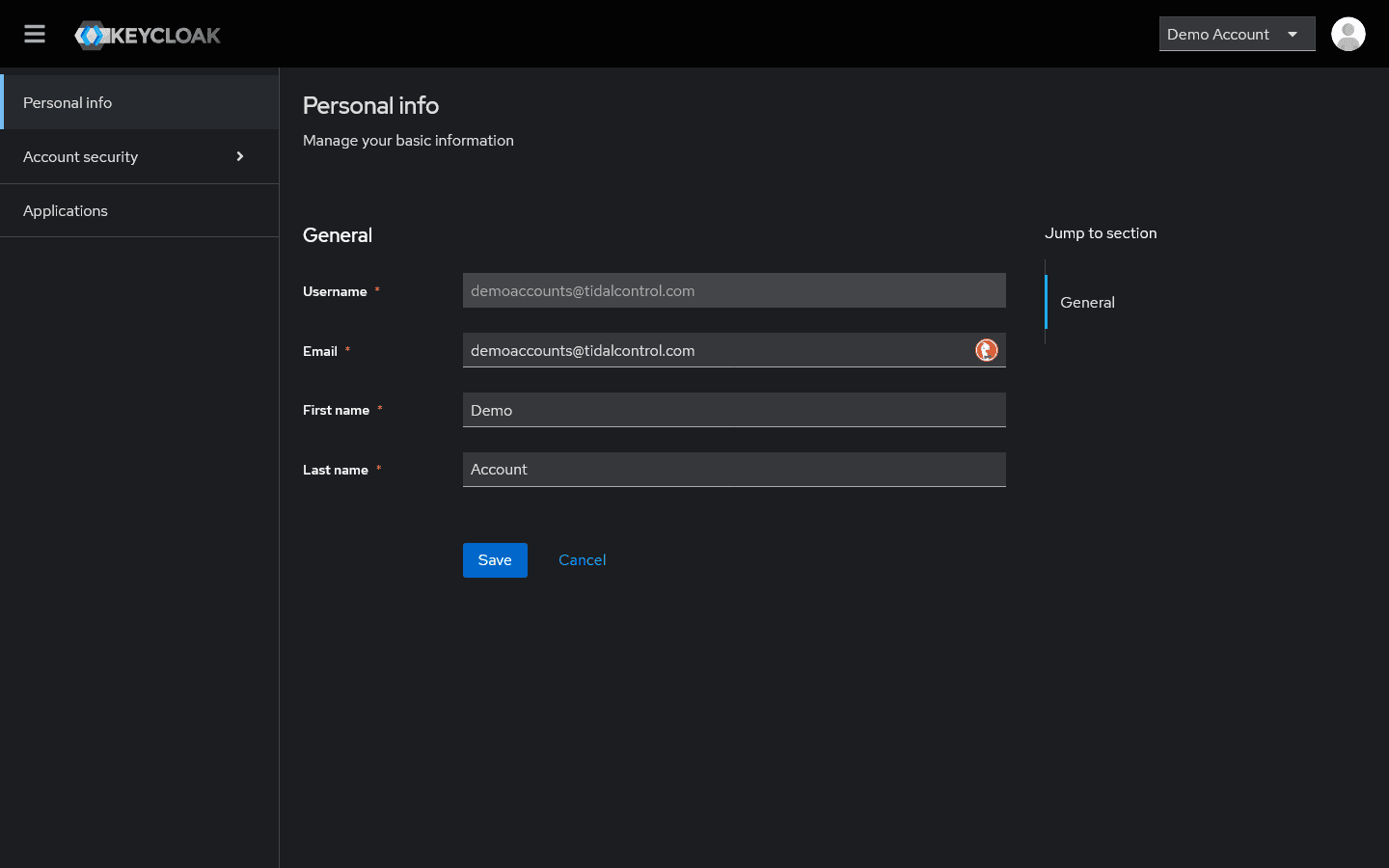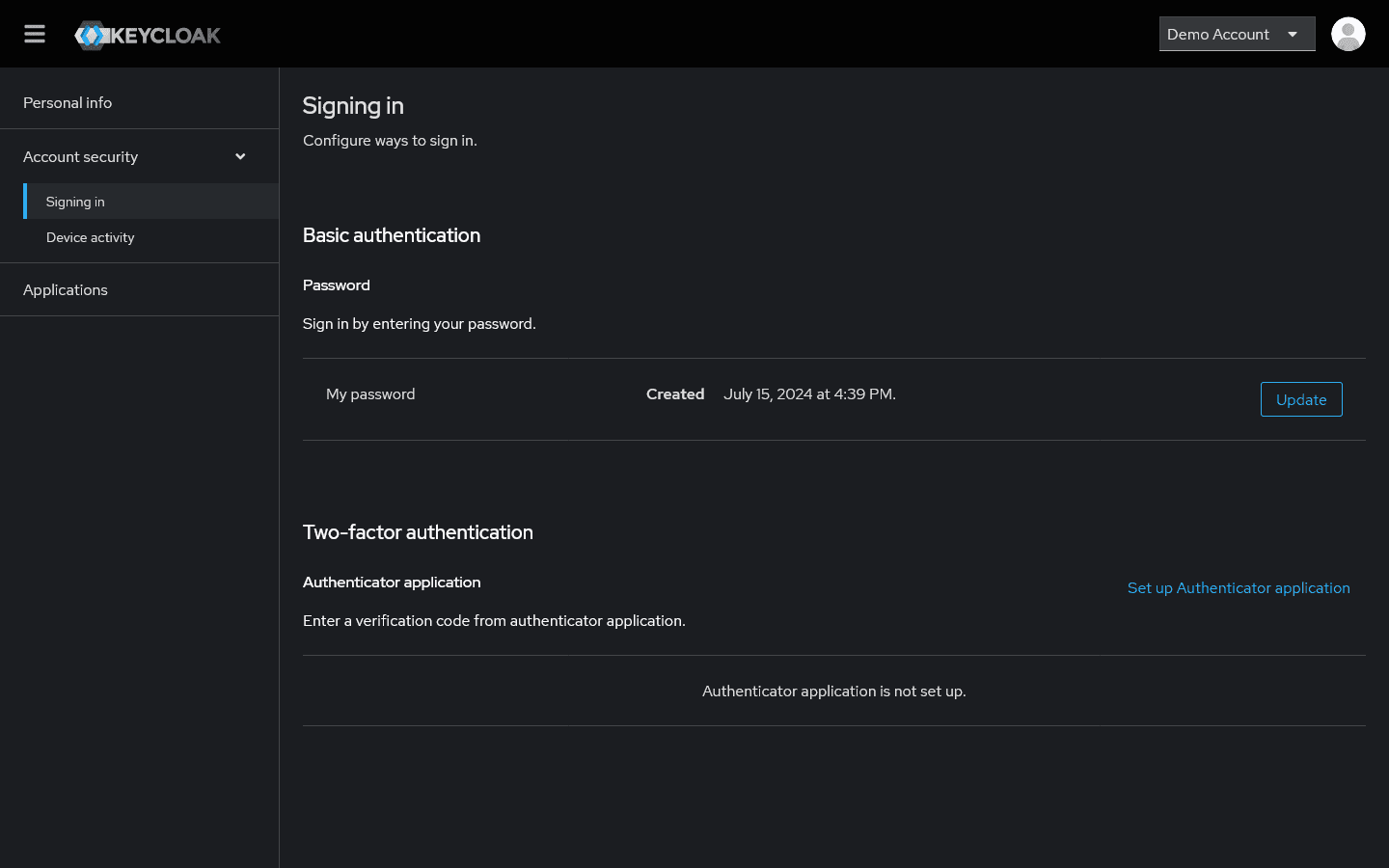Users
Getting started with user management
What is user management in Tidal Control?
User management in Tidal Control enables you to add team members, assign roles and manage access rights for your compliance organization.
Core functionalities:
- Central user administration - Manage all team members from one place
- Role-based access control - Different rights per user type
- Integrated authentication - Keycloak for secure login and profile management
- Invitation system - Invite users via email with account activation
- Ownership assignment - Link controls, assets and risks to users
Navigating the Users overview page
The Users page in Settings shows all team members with their roles and access rights in a clear table.

What you see in the overview:
- User table - All team members with basic information
- Search functionality - Quickly find specific users
- Add User button - Add new team members
- Actions menu - User actions per person
- Role management - Adjust rights per user
Understanding the user table
Column information:
- First Name / Last Name - First and last name of user
- Email - Login email address and communication
- Role - Current access rights level (dropdown for changes)
- Actions - Menu with user actions (dropdown for selection)
Example user information:
Alice Johnson | alice@tidalcontrol.com | Regular User | [Actions ⋮]
Bob Smith | bob@tidalcontrol.com | Regular User | [Actions ⋮]
Demo Account | demo@tidalcontrol.com | Super User | [Actions ⋮]
Actions menu options
Available actions per user:
- Send invite - Send invitation for account activation
- Reset password - Send password reset email
- Delete user - Permanently remove user from system
Understanding user roles
Tidal Control uses three main roles for access control, each with specific rights and limitations.

Read Only User
Access rights:
- View all compliance data (controls, assets, risks)
- Dashboard and reports access
- Audit trails and history consultation
Cannot:
- Create, modify controls, assets or risks
- Participate in control tests or assessments
- Be assigned as owner of compliance objects
- Execute tasks or upload evidence
Use for:
- External auditors who only need access
- Management wanting overview without execution rights
- Consultants for reporting and analysis
Regular User
Access rights:
- Everything from Read Only User plus execution rights
- Participate in control tests and assessments
- Upload evidence and execute tasks
- Be assigned as owner of controls and assets
- View reports and contribute to compliance activities
Cannot:
- Create, modify or delete other users
- Adjust global settings
- Change system-wide configuration
Use for:
- Compliance staff working daily with the system
- Control owners responsible for implementation
- Team members executing tests and collecting evidence
Super User (Administrator)
Access rights:
- Everything from Regular User plus administrative rights
- Create, modify and delete users
- Configure global settings
- Manage integrations and system configuration
- Full access to all functionalities
Use for:
- IT administrators maintaining the system
- Compliance managers with full responsibility
- Implementation specialists during setup
Every environment must have at least one Super User. The last Super User cannot be deleted.
Role selection strategy
Determine role based on:
- Daily work - What tasks does the person perform?
- Responsibility level - How critical is their contribution?
- Security principle - Minimum rights for function execution
- Organization hierarchy - Does role fit position and authorities?
If your organization uses Strict Mode (see indicator top right of screen) then Regular Users ONLY have access to controls, risks, tasks etc. that they are directly or indirectly linked to.
Read more about this in Using Strict Mode.
Recognizing login mechanisms
Tidal Control supports different login methods visible via labels in the user table. Each user has standard username/password authentication, but may have additional security layers configured.
Two-Factor Authentication (2FA):
- What: Second verification step besides your password via authenticator app
- How: After password entry, scan a code from Google Authenticator or similar app
- Use: User can set this up themselves, but this can also be centrally enforced.
Single Sign-On (SSO):
- What: Single login gives access to all business applications
- How: Via organization identity provider (Azure AD, Google Workspace, LDAP)
- Benefit: Users only need to remember one password, IT has central control
- Use: This must be configured centrally.
Send an email to support@tidalcontrol.com and we'll set it up for you. Additional license costs apply to using Single Sign-On.
The use of 2FA and SSO can be monitored via the users overview:

The following labels are possible:
- No label - Standard username/password login via Keycloak (sufficiently secure)
- 2FA label - Two-factor authentication active besides username/password (optimally secured)
- SSO label - Single Sign-On configured for organization-wide access (optimally secured)
- SSO + exclamation mark (⚠️) - Both methods active, user can still login with username/password despite SSO configuration (sufficiently secure)
Security recommendation: When implementing SSO, it's wise to disable local username/password access to enforce consistent security policy.
Managing your own profile
Tidal Control uses Keycloak for secure authentication and personal profile management. Users can manage their own account data via the integrated Keycloak interface.

Personal information
Users can adjust themselves:
- Email - Contact email address
- First name / Last name - First and last name
- Personal preferences - Language and notification settings
Not adjustable
- Username - Login username
Authentication settings

Available security options:
- Password management - Change password and strength
- Two-factor authentication - Authenticator app configuration
- Device activity - Overview of login sessions
- Login history - Audit trail of access
Two-factor authentication benefits:
- Extra security layer - Protection against password compromise
- Compliance requirement - Often mandatory for compliance frameworks
- Authenticator app - Use your favorite Authenticator app
Searching and organizing users
Using search functionality
- Click in search bar "Press 'Enter' to search" at top of Users page
- Type name or email of desired user
- Click 'Enter' to filter results
- Clear search (X) to show all users
Sorting users
Sort options:
- First Name - Alphabetical by first name (default with arrow ↑)
- Last Name - Alphabetical by last name
- Email - Alphabetical by email domain
Click column header to change sort order between ascending and descending.
Access rights in practice
Regular User daily tasks
Typical work:
- Execute assigned control tasks
- Upload evidence as input for periodic assessments
- Provide status updates on controls
- View reports for own responsibilities
Super User management tasks
Administrative work:
- Onboard new team members
- Adjust roles for function changes
- Configure system settings
- Troubleshoot user access
Read Only User analysis tasks
Access work:
- View compliance status reports
- Support audit preparations
- Perform trend analyses
- Compile executive overviews
Next steps
Now that you know the user management interface:
- Identify team members who need access to Tidal Control
- Determine correct roles based on responsibilities
- Invite team members or plan gradual team rollout
- Previous
- Jira Cloud